Proton Therapy Equipment
The proton system can be divided into the cyclotron system, energy selection system, beam transport system, gantry system, beam delivery system and patient positioning system.


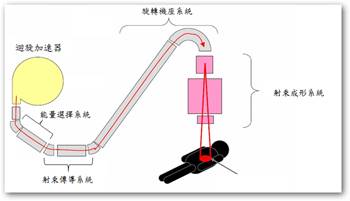
1) Cyclotron System
The cyclotron uses interior coils surrounding two pure iron poles to
generate a static magnetic field, which causes the charged protons
moving perpendicular to the magnetic lines to rotate for each
directional change. By using a microwave radio frequency device, it
provides specific energy to the proton during each rotation and
increases the radius of gyration at the appropriate time and place. To prevent the protons within the accelerator from interacting with other
substances and losing energy, the interior is kept in a vacuum state.
When protons are accelerated to maximum energy, deflectors cause
an angle in the rotation of protons and deliver them out of the
cyclotron. With the interaction of both motion mechanics and
electromagnetic physics, not only is the rotation frequency of the
proton fixed (fixed unit time and number of rotations), but every
round of rotation also provides a fixed amount of energy. Hence, this
accelerator is referred to as cyclotron. The proton therapy equipment
in the Chang Gung Memorial Hospital Proton Therapy Center uses the
cyclotron to generate static 230MeV proton beams for clinical
radiotherapy.
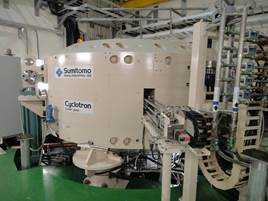

2) Energy Selection System
Protons with higher energy can penetrate deeper. Because the maximum
depth of a tumor can differ according to its location, the corresponding
proton energy must be selected to properly carry out proton therapy. The
energy a cyclotron generates is fixed at 230MeV. Clinical treatment requires
a unique energy selection system to reduce the energy to the necessary
level. The system contains an energy degrader and a series of devices to
restrict beam size and energy dispersal.
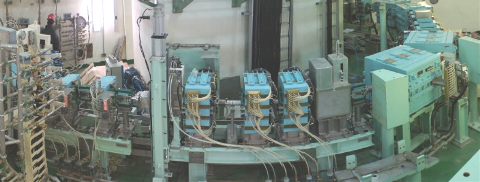
3) Beam transport system
The beam transport system consists of a dipole magnet, quadrupole magnet,
beam tuning coil and beam monitor. The dipole magnet is used to bend the
proton trajectory. The quadrupole magnet is used to focus the proton beam.
The beam tuning coil is used for fine adjustments to the proton beam
direction. The beam monitor is used to monitor beam performance. By using
a series of magnets to guide the protons moving in the vacuum channel and
by using the beam monitor to check proton position and beam size, the
proton beam’s good quality is maintained before reaching the treatment
rooms.

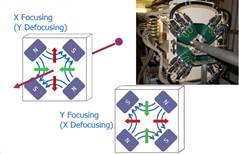
4) Gantry System
Our center has four treatment rooms. When protons pass through the
cyclotron, they are accelerated to a sufficient energy level before
being delivered through the beam transport system to each treatment
room for treating deep tumors. Since the protons cannot be delivered
to all treatment rooms simultaneously, only one treatment room can
be used at a time. Meanwhile, other treatment rooms are prepared
for the fixing and positioning of the patient. To treat tumors from all
directions, the proton therapy machine in each room is set up in a 17-
meter high space with a large rotating base with a diameter of 10.6 m
and a weight of 140 t. The machine’s interior contains a series of
dipole magnets, quadrupole magnets, beam tuning coils and beam
monitors to guide the protons to the rotating center in the treatment
room, with an error of less than 1 mm from the center.


5) Beam Delivery System
The proton therapy machine has two different treatment techniques to
meet the individual needs of tumor treatment, Pencil Beam Scanning and
Wobbling. The principle of Wobbling involves sending a narrow proton beam
through a magnetic field of the X- and Y-axes and deflectors while it expands
with a rotation of a specific radius into a broader beam with a wider range.
When it passes through the ridge filter, the vertical axis expands into SOBP,
passes through the compensator and collimator, and then conforms before
reaching the body. Another method that can reduce unnecessary normal
tissue dose involves using layer stacking and a multileaf collimator (MLC)
that can adjust the field size. This way, the dose distribution can be done as
shown in the figure. The figure clearly shows that the orange block, which
represents normal tissue, receives a much smaller dose. This advanced
technology is being used by our Proton Therapy Center. Since the energy
output of the cyclotron is fixed (230MeV), by using the energy selection
system (ESS), the energy level that reaches the treatment site can be
adjusted. Different energy levels can penetrate different depths. Therefore,
by using adjustment mechanisms, the tumor is divided into different layers
of the same width. Treatment starts from the deepest layer and gradually
moves upwards, while the use of the multileaf collimator follows the 3D
shape of the tumor. 。
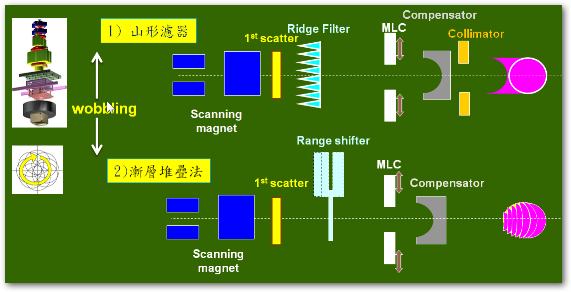
The principle of Pencil Beam Scanning involves sending a narrow proton beam through a magnetic field of the X- and Y-axes and distributing it directly in the field by scanning. This technique controls the weighted dose of each point in the field to achieve "Intensity Modulated Proton Therapy (IMPT)". This advanced technology is currently in the Proton Therapy Optimization Plan and is essentially the direction of the future of proton therapy.

6)Digital Imaging Positioning System:
To ensure the positional accuracy of proton therapy, every treatment
room is equipped with a digital imaging guiding system, which acquires
images through three different methods: digital radiography, fluoroscopy
and computed tomography.
A. Digital radiography can acquire two orthogonal two-dimensional images to match the treatment site.
B. Fluoroscopy can view lesion displacement caused by a variety of reasons, such as breathing, and adjust treatment to such breathing with the aid of proton therapy equipment.
C. Computed tomography is used to compare its image with the simulated image from the computer treatment plan system to ensure the accuracy of the treatment site.
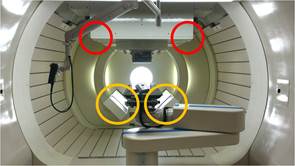
X-ray Imaging Positioning System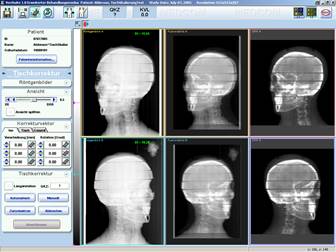
Digital Radiography
Robotic Couch: after the Digital Imaging Positioning System determines
the correct patient position on the couch, this information is immediately
sent to the robotic couch for a 6-dimensional shift. The robotic couch is a
specialized couch developed by combining an industrial computer-controlled
robotic arm and a radiotherapy couch. The robotic couch has a total of six
drive motors, which enable it to move along six axes and rotate with an
accuracy of 0.01 mm. Not only can it measure the weight of a patient
(maximum user weight 200 kg), but it can also compensate for inclinations
due to weight. It is the most advanced and accurate couch among
radiotherapy equipment today.
